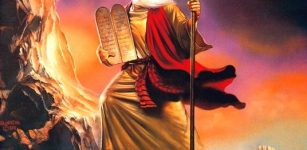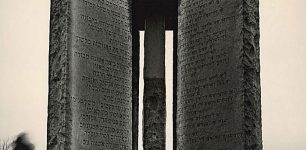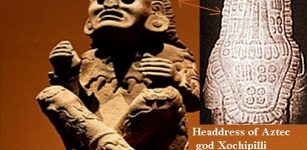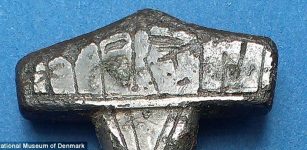Roman Square Capitals: Prestigious Script That Delighted Human Eye With Its Elegance
A. Sutherland - AncientPages.com - We have been using this cultural achievement of the ancient Romans for at least 2,500 years.
Roman square capitals (also called capitalis monumentalis, or capitalis quadrata), are an ancient Roman form of writing and the basis for modern capital letters.
 The 5th-century Vergilius Romanus work. Source
The 5th-century Vergilius Romanus work. Source
The earliest Roman script was entirely in capitals, and in all eras, this form of writing delighted the human eye with its elegance.
To this day, the Roman square capitals can be admired on old stone inscriptions. Before the 4th century, square capitals were used to write de luxe copies of the works. The only three surviving manuscripts using this letter, among them the ‘Vergilius Augustus’, contains works by Virgil.
They look like printed today, and yet they required immensely more work than inserting a card into the printer and merely pressing ‘enter,’ as we do today.
This script – not only elegant but also beautiful – was believed to be exclusively reserved for valuable manuscripts and used for the most important and revered works such as Virgil or the Holy Bible.
Square capitals were indeed very difficult to write because of their straight lines and right angles.
The scribe was undoubtedly a skilled person. He had to plan the inscription on a given surface, drew auxiliary lines, like in a school notebook, then sketched the outline of letters, and then forged them with a chisel.
The work required high precision; the material did not tolerate errors. This writing was much more suited for carving inscriptions on the stone using a chisel. It was not recommended for a text written on parchment or papyrus with a pen.
Roman square capitals are also called "Elegant Capitals" and represent an ancient Roman form of writing, and the introduction for our modern capital letters. Used in manuscripts and inscriptions, the Roman capitals were often written without breaks between words, or with words separated by dots.
 Roman square capitals on the Arch of Titus, c. AD 81. Source
Roman square capitals on the Arch of Titus, c. AD 81. Source
The font of the formal Roman script was based on typography, in which most letters could be written in a square. Square capitals had sharp, straight lines; the angles were also used but only the right ones.
This form of writing was undoubtedly exquisite and is found in the city of Rome on inscriptions that decorate Trajan's Column, the Arch of Titus, and the Roman Pantheon all in Rome.
However, after the 5th century, the square capitals fell out of use and became less frequent; the script was stiff and very slow to write. The Romans used a current cursive hand known as Latin cursive for everyday writing, as we know it very well, today.
The ancient Roman script was based on a modified Greek alphabet.
 The Lyon Tablet, a bronze tablet from after AD 48. Source
The Lyon Tablet, a bronze tablet from after AD 48. Source
According to Roman legend, the Cimmerian Sibyl, Carmenta, adapted the Greek alphabet used in the Greek colony of Cumae in southern Italy, to create the Latin alphabet. The legend says that this alphabet was introduced to Latium by Evander, her son, and it took place sixty years after the Trojan War.
Officially, the Latin, (or Roman alphabet) was adapted from the Etruscan alphabet during the 7th century BC to create Latin. Since then, it had different forms, and was adapted to form many languages.
At the time of the splendor of the Roman Empire, the Latin alphabet had 23 letters. Initially, there was no letter 'W,' which was added later in the Middle Ages, and derived from two letters 'V' placed next to each other.
During the Renaissance ((14th–17th centuries), the letter 'J' began with the letter 'I,' and the letter 'U' with the letter 'V' began to budge. The introduction of lowercase letters, based on the Greek alphabet, improved the readability and speed of rewriting texts.
The most popular computer font, ‘Times New Roman’ is a derivative of the square capital. It was created in 1929 at the request of the British newspaper Times. The font was designed by Stanley Morison from Monotype. Because the newspaper publisher used the printing machinery of a competitor, Linotype, Monotype had to license it.
Linotype began advertising the font as 'Times Roman'. The font itself, though modeled on classic Roman writing, is narrower, adapted to the narrow columns of the newspaper.
Written by - A. Sutherland - AncientPages.com Senior Staff Writer
Copyright © AncientPages.com All rights reserved. This material may not be published, broadcast, rewritten or redistributed in whole or part without the express written permission of AncientPages.com
Expand for referencesReferences:
Avrin L. Scribes, Script, and Books: The Book Arts from Antiquity to the Renaissance
More From Ancient Pages
-
 Hidden Bronze and Iron Treasures Found In Prehistoric Hillfort In Northeast Hungary
Archaeology | Oct 9, 2024
Hidden Bronze and Iron Treasures Found In Prehistoric Hillfort In Northeast Hungary
Archaeology | Oct 9, 2024 -
 Girl’s Ancient Tooth Solves One Of The Biggest Mysteries Of The Denisovans
Archaeology | May 17, 2022
Girl’s Ancient Tooth Solves One Of The Biggest Mysteries Of The Denisovans
Archaeology | May 17, 2022 -
 Roman Consuls Seized Power Through Intimidation, Bribery And Show Business
Ancient History Facts | Mar 4, 2025
Roman Consuls Seized Power Through Intimidation, Bribery And Show Business
Ancient History Facts | Mar 4, 2025 -
 World’s Oldest Dala Horse Discovered In Sweden
Archaeology | Jul 18, 2020
World’s Oldest Dala Horse Discovered In Sweden
Archaeology | Jul 18, 2020 -
 Large Pre-Columbian Pyramid Discovered Under Highway In Mexico But It Will Not Be Excavated
Archaeology | Dec 16, 2024
Large Pre-Columbian Pyramid Discovered Under Highway In Mexico But It Will Not Be Excavated
Archaeology | Dec 16, 2024 -
 Bad King John’s Lost Treasure May Be Hidden Near The Walpole Marsh In The Fenlands – Archaeologists Say
Archaeology | Mar 27, 2024
Bad King John’s Lost Treasure May Be Hidden Near The Walpole Marsh In The Fenlands – Archaeologists Say
Archaeology | Mar 27, 2024 -
 What The Egg Crisis Reveals About Our Food System
Archaeology | Apr 24, 2023
What The Egg Crisis Reveals About Our Food System
Archaeology | Apr 24, 2023 -
 The Controversial History Of Moses – Who Was He Really?
Biblical Mysteries | Sep 13, 2015
The Controversial History Of Moses – Who Was He Really?
Biblical Mysteries | Sep 13, 2015 -
 Amrita: Potion Of Immortality Consumed By Gods To Make Them Strong And Immortal
Featured Stories | Apr 5, 2019
Amrita: Potion Of Immortality Consumed By Gods To Make Them Strong And Immortal
Featured Stories | Apr 5, 2019 -
 ‘Georgia Guidestones’: Bizarre Ominous And Strange Monument In North America
Featured Stories | Mar 27, 2022
‘Georgia Guidestones’: Bizarre Ominous And Strange Monument In North America
Featured Stories | Mar 27, 2022 -
 Viking Longships: Fearless Dragonships Daring The Oceans And Seas
Ancient History Facts | Apr 16, 2016
Viking Longships: Fearless Dragonships Daring The Oceans And Seas
Ancient History Facts | Apr 16, 2016 -
 Darabgerd: One Of The Oldest Cities Dated To Achaemenid Era
Featured Stories | Jan 28, 2021
Darabgerd: One Of The Oldest Cities Dated To Achaemenid Era
Featured Stories | Jan 28, 2021 -
 Robert The Bruce: Mighty King Of Scots And Great Scottish Hero
Featured Stories | Oct 13, 2016
Robert The Bruce: Mighty King Of Scots And Great Scottish Hero
Featured Stories | Oct 13, 2016 -
 Xochipilli: Aztec God Of Love, Music, Song And Ecstatic Mushroom Trance
Aztec Mythology | May 19, 2018
Xochipilli: Aztec God Of Love, Music, Song And Ecstatic Mushroom Trance
Aztec Mythology | May 19, 2018 -
 Wayland The Smith: Legendary Master Blacksmith And Lord Of The Elves
Featured Stories | Jul 14, 2016
Wayland The Smith: Legendary Master Blacksmith And Lord Of The Elves
Featured Stories | Jul 14, 2016 -
 Codes Of Ur Nammu: World’s Oldest Known Law Code
Ancient History Facts | Mar 11, 2016
Codes Of Ur Nammu: World’s Oldest Known Law Code
Ancient History Facts | Mar 11, 2016 -
 Remarkable Discovery Of Unusual “Hammer Of Thor” Finally Solves An Ancient Mystery
Archaeology | Jul 2, 2014
Remarkable Discovery Of Unusual “Hammer Of Thor” Finally Solves An Ancient Mystery
Archaeology | Jul 2, 2014 -
 Discovery Of Camouflaged Ancient Stone Chest In Egyptian Temple May Reveal Hidden Royal Tomb – Who Is Buried Near Hatshepsut’s Temple?
Archaeology | Mar 10, 2020
Discovery Of Camouflaged Ancient Stone Chest In Egyptian Temple May Reveal Hidden Royal Tomb – Who Is Buried Near Hatshepsut’s Temple?
Archaeology | Mar 10, 2020 -
 Runes: Facts And History About Odin’s Secret Language
Ancient History Facts | Jan 27, 2016
Runes: Facts And History About Odin’s Secret Language
Ancient History Facts | Jan 27, 2016 -
 Arrowhead Made Of Meteoritic Iron From The Late Bronze Age Settlement Of Mörigen, Switzerland – Examined
Archaeology | Aug 1, 2023
Arrowhead Made Of Meteoritic Iron From The Late Bronze Age Settlement Of Mörigen, Switzerland – Examined
Archaeology | Aug 1, 2023
